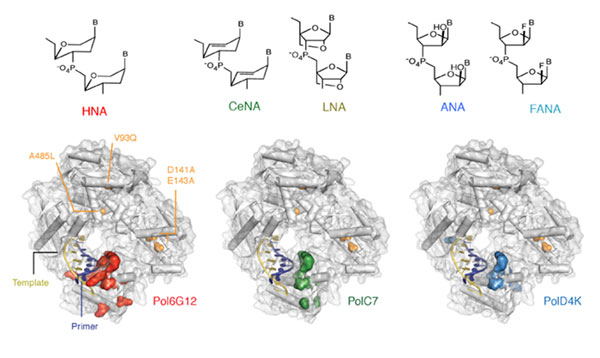
Research
XNA

DNA and its close relative RNA form the genetic material of all life on earth - the form the blueprint of every living organism. We asked the question if this function is unique or if alternative means for genetic information storage and propagation are conceivable.
Indeed, a good argument can be made in favour of their uniqueness. DNA and RNA display a range of physical and chemical properties that render them exceptionally well suited to store genetic information. While alternative nucleic acid chemistries and the design of synthetic nucleic acid analogues (termed xeno-nucleic acids (XNAs)) have been methodically explored, it had remained unclear how many (if any) XNAs would have the potential to serve as genetic materials.
Using nucleic acid chemistry and protein evolution and design we have been able to describe so far eight alternative genetic materials (XNAs) with a clear capacity for information storage and propagation and, in the case of HNA, evolution [1, 2].
This work shows that the fundamental functions of DNA and RNA can be carried out by simple synthetic genetic polymers not found in nature. Thus, heredity and evolution, two hallmarks of life, are likely to be general emergent properties of polymers capable of information storage with implications for the understanding of the origin of life on Earth and for the detection of potential non-terran biologies.
The new synthetic genetic polymers also offer opportunities in biotechnology and promise a new class of biopolymer-based ligands and materials for applications in diagnosis and therapy.
- Synthetic genetic polymers capable of heredity and evolution.
Pinheiro VB, Taylor AI, Cozens C, Abramov M, Renders M, Zhang S, Chaput JC, Wengel J, Peak-Chew SY, McLaughlin SH, Herdewijn P, Holliger P.
Science. 2012; 336 : 341-4. - A short adaptive path from DNA to RNA polymerases.
Cozens C, Pinheiro VB, Vaisman A, Woodgate R, Holliger P.
Proc Natl Acad Sci U S A. 2012; 109 : 8067-72.